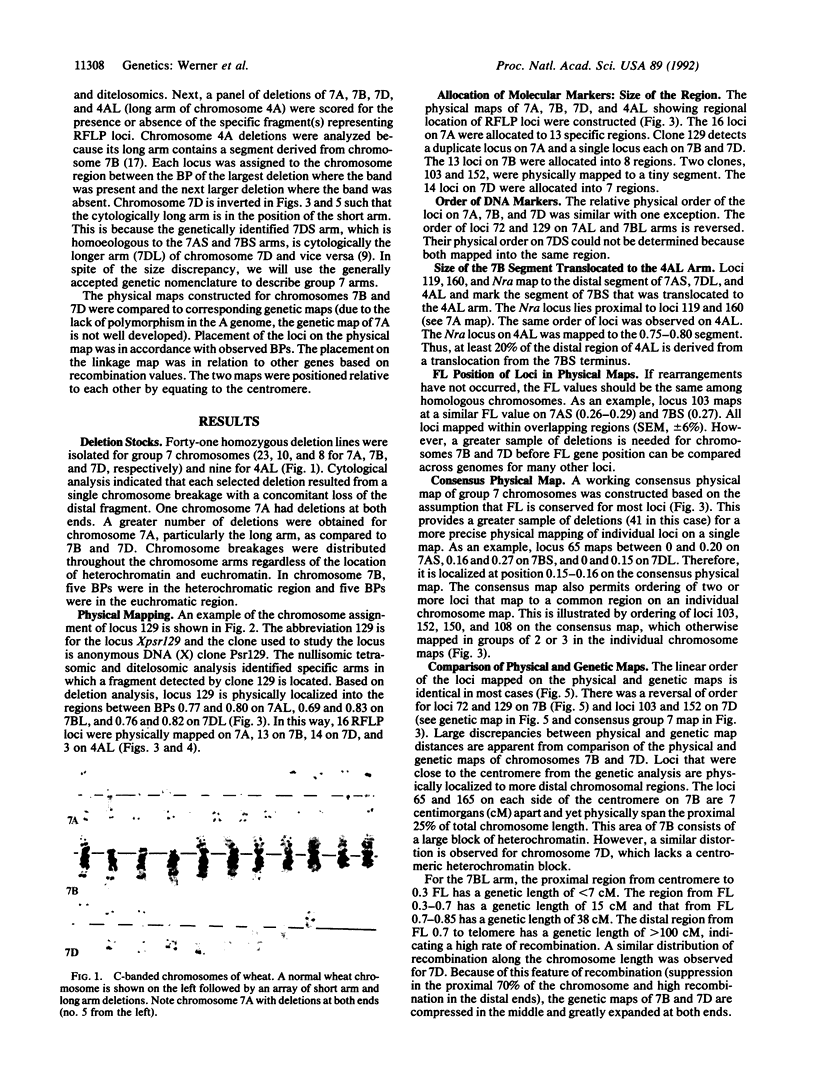Abstract
Bread wheat (Triticum aestivum L. em Thell) is well suited for cytogenetic analysis because the genome, buffered by polyploidy, can tolerate structurally and numerically engineered chromosomes for analysis over infinite generations. This feature of polyploidy can be used in developing a high-resolution, cytogenetically based physical map of the wheat genome. We show that numerous deletions, observed in the progeny of a monosomic addition of a chromosome from Triticum cylindricum in wheat, result from single breakpoints and a concomitant loss of distal fragments. Breakages occurred in euchromatic and heterochromatic regions. Forty-one deletions for chromosomes 7A, 7B, and 7D, and a set of genetically mapped DNA probes, were used to construct physical maps. Recombination was low in proximal chromosomal regions and very high toward the distal ends. Deletion mapping was more efficient than genetic mapping in resolving the order of proximal loci. Despite variation in size and arm ratio, relative gene position was largely conserved among chromosomes 7A, 7B, and 7D and a consensus group 7 physical map was constructed. Several molecularly tagged chromosome regions (MTCRs) of approximately one to a few million base pairs were identified that may be resolved by long-range mapping of DNA fragments. Thus, a cytogenetically based physical map may be used to integrate chromosome and DNA-based maps. The MTCRs may simplify strategies for cloning of agronomically useful genes despite the genetic complexity and the large genome size of wheat.
Full text
PDF




Images in this article
Selected References
These references are in PubMed. This may not be the complete list of references from this article.
- Cox D. R., Burmeister M., Price E. R., Kim S., Myers R. M. Radiation hybrid mapping: a somatic cell genetic method for constructing high-resolution maps of mammalian chromosomes. Science. 1990 Oct 12;250(4978):245–250. doi: 10.1126/science.2218528. [DOI] [PubMed] [Google Scholar]
- Feinberg A. P., Vogelstein B. A technique for radiolabeling DNA restriction endonuclease fragments to high specific activity. Anal Biochem. 1983 Jul 1;132(1):6–13. doi: 10.1016/0003-2697(83)90418-9. [DOI] [PubMed] [Google Scholar]
- Hofker M. H., Smith S., Nakamura Y., Teshima I., White R., Cox D. W. Physical mapping of probes within 14q32, a subtelomeric region showing a high recombination frequency. Genomics. 1990 Jan;6(1):33–38. doi: 10.1016/0888-7543(90)90445-z. [DOI] [PubMed] [Google Scholar]
- Hulbert S. H., Richter T. E., Axtell J. D., Bennetzen J. L. Genetic mapping and characterization of sorghum and related crops by means of maize DNA probes. Proc Natl Acad Sci U S A. 1990 Jun;87(11):4251–4255. doi: 10.1073/pnas.87.11.4251. [DOI] [PMC free article] [PubMed] [Google Scholar]
- Kojima T., Tsuchida Y., Hirasé Y., Endo T. Reverse vascular pedicle digital island flap. Br J Plast Surg. 1990 May;43(3):290–295. doi: 10.1016/0007-1226(90)90074-a. [DOI] [PubMed] [Google Scholar]
- Lambie E. J., Roeder G. S. A yeast centromere acts in cis to inhibit meiotic gene conversion of adjacent sequences. Cell. 1988 Mar 25;52(6):863–873. doi: 10.1016/0092-8674(88)90428-x. [DOI] [PubMed] [Google Scholar]
- Meagher R. B., McLean M. D., Arnold J. Recombination within a subclass of restriction fragment length polymorphisms may help link classical and molecular genetics. Genetics. 1988 Nov;120(3):809–818. doi: 10.1093/genetics/120.3.809. [DOI] [PMC free article] [PubMed] [Google Scholar]
- Nussbaum R. L., Lesko J. G., Lewis R. A., Ledbetter S. A., Ledbetter D. H. Isolation of anonymous DNA sequences from within a submicroscopic X chromosomal deletion in a patient with choroideremia, deafness, and mental retardation. Proc Natl Acad Sci U S A. 1987 Sep;84(18):6521–6525. doi: 10.1073/pnas.84.18.6521. [DOI] [PMC free article] [PubMed] [Google Scholar]
- Orkin S. H. Reverse genetics and human disease. Cell. 1986 Dec 26;47(6):845–850. doi: 10.1016/0092-8674(86)90799-3. [DOI] [PubMed] [Google Scholar]
- Szauter P. An analysis of regional constraints on exchange in Drosophila melanogaster using recombination-defective meiotic mutants. Genetics. 1984 Jan;106(1):45–71. doi: 10.1093/genetics/106.1.45. [DOI] [PMC free article] [PubMed] [Google Scholar]
- Wicking C., Williamson B. From linked marker to gene. Trends Genet. 1991 Sep;7(9):288–293. doi: 10.1016/0168-9525(91)90310-M. [DOI] [PubMed] [Google Scholar]




